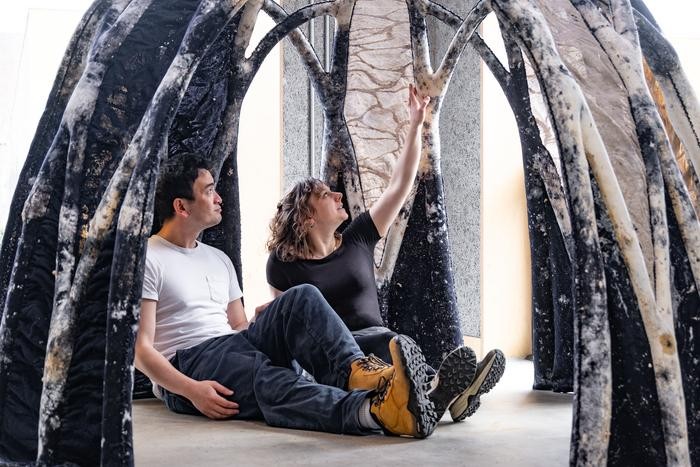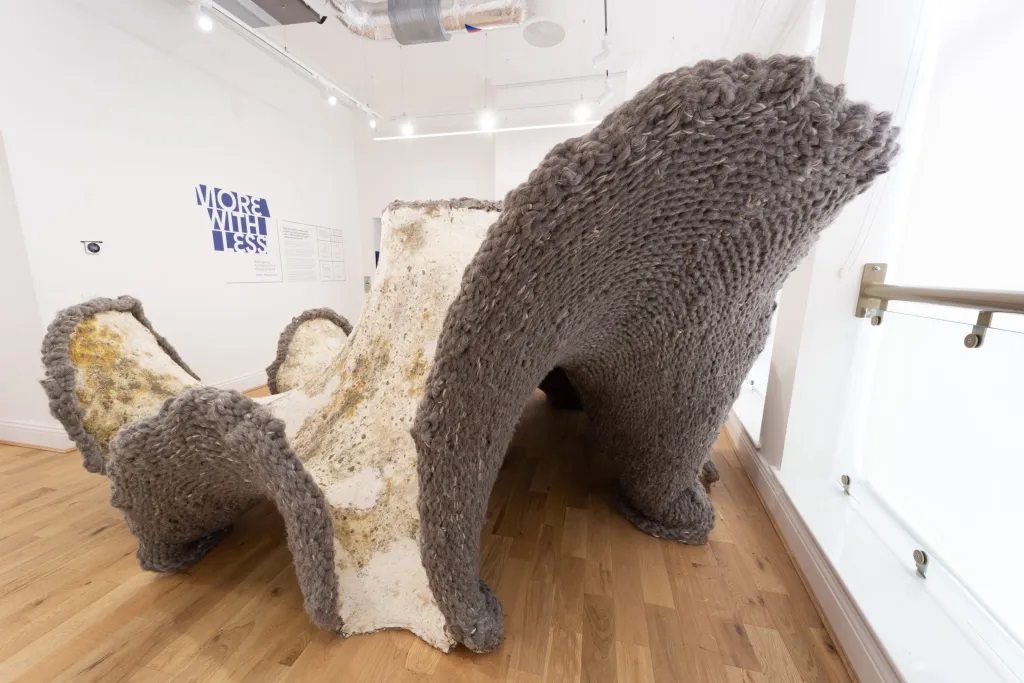In the 1960s, mushroom use became associated with psychedelia and youth counterculture, the so-called hippies. Today, researchers are studying other fungi for much different purposes. Mycelium, for example, is a web of fungal fibers that can flourish in organic refuse and dimness. It might serve as a foundation for eco-friendly flame-resistance. At the RMIT (Royal Melbourne Institute of Technology) in Australia, scientists are manipulating mycelium’s structure chemically to enhance its fire-inhibiting characteristics.
Typically, fungi are discovered in a composite form blended with residual feed material. However, RMIT discovered a method to cultivate pure mycelium sheets that can be layered and engineered for various applications. These range from flat panels intended for the construction sector to a material resembling leather for the fashion industry.
The innovative technique of producing paper-thin mycelium sheets, akin to wallpaper, is achieved without pulverizing the filament network of the mycelium. Rather, researchers employed alternative growth conditions and chemicals to create the thin, consistent, and crucially fire-resistant material.
Fungi fireproofing buildings
The researchers are primarily dedicated to developing bio-derived, fire-retardant cladding for buildings, with a specific focus on preventing tragedies similar to the Grenfell Tower fire in London. Experts said in that case, the exterior cladding of composite foam sandwich panels helped spread the fire quickly from the lower floors all the way up the block. The 2017 fire killed 72 people.
Mycelium possesses a notable advantage in its ability to generate a thermal protective char layer when subjected to fire or radiant heat. The endurance of mycelium char at higher temperatures and for longer durations enhances its efficacy as a fireproof material.
In addition to its effectiveness, mycelium-based cladding can be manufactured from renewable organic waste. Where composite cladding panels are used, they usually contain plastics—which produce toxic fumes and heavy smoke when they burn. While fire retardants containing bromide, iodide, phosphorus, and nitrogen may be effective, they also come with detrimental health and environmental consequences. These substances, which can act as carcinogens and neurotoxins, have the potential to escape and persist in the environment, causing harm to both plant and animal life. Mycelium, on the other hand, does not pose similar harm to people or the environment when burned. This makes it an environmentally friendly option for fireproofing applications.
RMIT has received interest from the mushroom industry and by collaborating with the industry, it would eliminate the necessity for new farms while generating fire-safe products in an environmentally sustainable manner. This collaborative approach holds promise for meeting fire safety requirements while reducing environmental impact.
The researchers are currently exploring the development of fungal mats that are reinforced with engineered fibers. This approach aims to prolong ignition, decrease the intensity of flames, and enhance the fire safety ranking of the materials. By combining fungal mats with engineered fibers, they seek to further enhance the fire-resistant properties and overall safety of the products.
Moving well beyond the concept of using fungi for cladding, a team of designers, engineers, and scientists in the Living Textiles Research Group, part of the Hub for Biotechnology in the Built Environment at Newcastle University, are hoping to reduce the environmental impact of the construction industry by developing a way to grow building materials using knitted molds and the root network of fungi.
Although researchers have experimented with similar composites before, the shape and growth constraints of the organic material have made it hard to develop diverse applications that fulfil its potential. Using the knitted molds as a flexible framework, scientists created a composite called “mycocrete,” which is stronger and more versatile in terms of shape and form, allowing them to grow lightweight and relatively eco-friendly construction materials.
To make composites using mycelium, part of the root network of fungi, scientists mix mycelium spores with grains they can feed on and material that they can grow on. This mixture is packed into a mold and placed in a dark, humid, and warm environment so that the mycelium can grow, binding the substrate tightly together. Once it’s reached the right density, but before it starts to produce the fruiting bodies—mushrooms—it is dried out. This process could provide a cheap, sustainable replacement for foam, timber, and plastic.
But mycelium needs oxygen to grow, which constrains the size and shape of conventional rigid molds and limits current applications. Knitted textiles offer a possible solution: oxygen-permeable molds that could change from flexible to stiff with the growth of the mycelium. But textiles can be too yielding, and it is difficult to pack the molds consistently.

Samples of conventional mycelium composite were prepared by the scientists as controls, and grown alongside samples of mycocrete, which also contained paper powder, paper fiber clumps, water, glycerin, and xanthan gum. This paste was designed to be delivered into the knitted formwork with an injection gun to improve packing consistency: the paste needed to be liquid enough for the delivery system, but not so liquid that it failed to hold its shape.
Tubes for their planned test structure were knitted from merino yarn, sterilized, and fixed to a rigid structure while they were filled with the paste, so that changes in tension of the fabric would not affect the performance of the mycocrete.
Once dried, samples were subjected to strength tests in tension, compression, and flexion. The mycocrete samples proved to be stronger than the conventional mycelium composite samples and outperformed mycelium composites grown without knitted formwork. In addition, the porous knitted fabric of the formwork provided better oxygen availability, and the samples grown in it shrank less than most mycelium composite materials do when they are dried, suggesting more predictable and consistent manufacturing results could be achieved.
The team also built a larger proof-of-concept prototype structure called BioKnit—a complex freestanding dome constructed in a single piece without joints that could prove to be weak points, thanks to the flexible knitted form.
Following the first successful BioKnit prototype, researchers created The Living Room by developing the techniques to grow mycelium-textile hybrids further. The Living Room is a bio-fabricated architecture that is grown using locally available waste materials. It is composed of Herdwick wool, a breed of sheep native to the Lake District in north-west England, a mix of sawdust and wastepaper from local mills, and mycelium spores.

The use of waste materials benefits regional industries and demonstrates a means to dramatically reduce the environmental impact of construction, while allowing reimaging of the space. What they created was what they described as “a soft, cozy, snug internal space with thick sculpted walls, which can be composted when no longer required.”
Want to tweet about this article? Use hashtags #construction #sustainability


